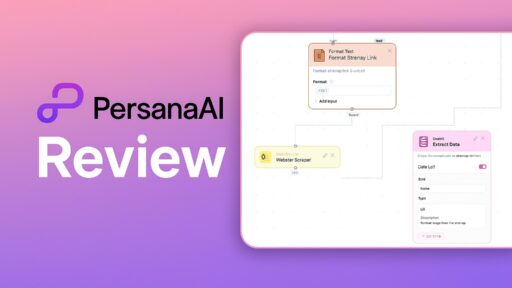Last Updated: December 5, 2025
During my first two weeks of using Clay, I burned through more than $700 in phone credits – and many of those enrichments were inaccurate. That experience pushed me to look at Clay alternatives that could handle enrichment, and GTM workflows without unpredictable costs.
I tested 10 different tools. This guide summarizes what I observed across each platform: data accuracy, pricing models, ease of use, and where each one performs better or differently than Clay.
Building a Clay alternative? I’m updating this list in 2026. Email henley@revealera.com to be considered for inclusion.
- Focused on overall data enrichment
- Freckle.io – best for ease of use and ability to try everything (Free To Try)
- Airscale – best for sales prospecting, building lists, and overall value (Free To Try)
- Exa Websets – also easy and simpler to use than Clay (Free To Try)
- Hubspot Breeze Intelligence – Company-only enrichment for existing Hubspot users (Free To Try) Focused on data enrichment + GTM orchestration
- Persana AI – best for signal-based GTM orchestration (Requires Demo)
- Floqer – also good for signal-based GTM orchestration (Requires Demo) Focused on contact data enrichment only
- FullEnrich – best for contact-only enrichment (Free To Try)
- Cognism – best for European contact data enrichment (Requires Demo) All-in-one platforms (enrichment, orchestration AND outreach)
- Apollo.io – best if you prefer an all-in-one platform (Free To Try) DIY, most cost-friendly alternative
- Google Sheets + N8N + Apify (Free To Try)
What to look for in a Clay.com alternative
First is price. Clay’s cheapest plan is $149/month for 2,000 credits. That’s $0.07 per credit. In my experience, new users can easily spend $500–$800 in their first week while they’re still learning how the platform works.
What to look for: Transparent pricing models. Flat monthly fees or pay-per-success pricing. Tools that don’t charge you for failed enrichments or inaccurate data.
Clay also has a relatively steep learning curve. Many companies end up hiring Clay consultants or GTM engineers just to operate the tool efficiently.
What to look for: Intuitive interfaces your team can actually use without engineering support. Simple onboarding that takes hours, not weeks.
Then there’s data quality. In my own workflows, I ran into issues like stale contact information, weaker coverage for SMBs and service businesses, and phone numbers that didn’t connect.
What to look for: High match rates with verified data. Providers that specialize in your market. Waterfall enrichment that actually improves coverage.
CRM integration is essential for most GTM teams. With Clay, you need the $800/month Pro plan just to connect to Salesforce or HubSpot.
What to look for: Native syncing with Salesforce, HubSpot, and other major platforms without paying premium prices.
Finally, you need features that match your actual workflow. Clay tries to do everything, which can mean you’re paying for capabilities you may never use.
Now let’s get into the list.
1. Freckle.io – Best for ease of use and ability to try everything
Pros: Easy to use, free self-serve trial, simple pricing, quick to release new features
Cons: No signal orchestration, supports Hubspot/Salesforce CRMs only
Freckle.io is a relatively new Clay competitor (they recently raised $5M in funding). It’s built especially for connecting to your CRM, cleaning/enriching your contacts and synching that data back.
If you’re not using a CRM though, you can also create your initial table by uploading a CSV, searching Google Maps, finding company lookalikes, or simply manually adding rows.
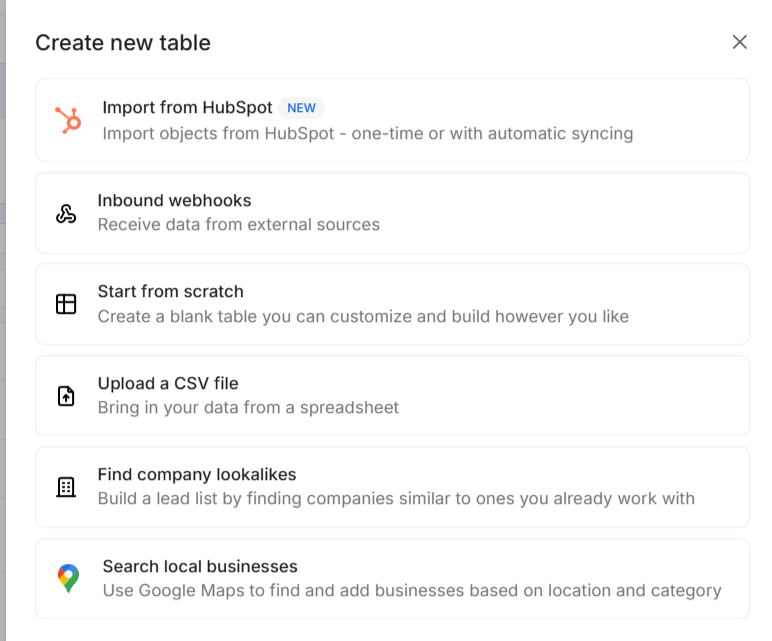
Though the options are a bit fewer than what Clay offers, I found them fairly robust in practice. For example, when I tried creating a lookalike list from 3 websites: unifygtm.com, commonroom.io, and pocus.com, it generated a very accurate list of lookalike companies.
Once you create your initial table, the user interface looks very similar to Clay’s as you can see in the screenshot below. I actually found it cleaner, faster, more intuitive, and more robust in day-to-day use. It’s very similar to Clay, except it doesn’t come with as steep of a learning curve.
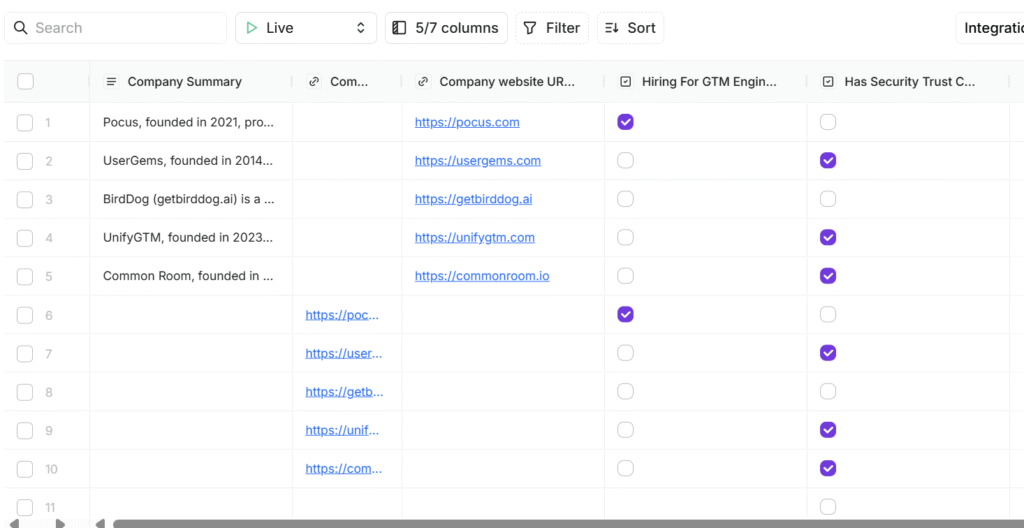
Once you have your table created (whether it’s by importing from Hubspot, or creating it from scratch), you can start adding columns to enrich your data… and this is where their simplicity/ease of use stands out.
Instead of choosing what specific data source you want to use, you just use natural language to describe your field, and Freckle does all the work in deciding what data source to query in the backend.
Let me show you what I mean…
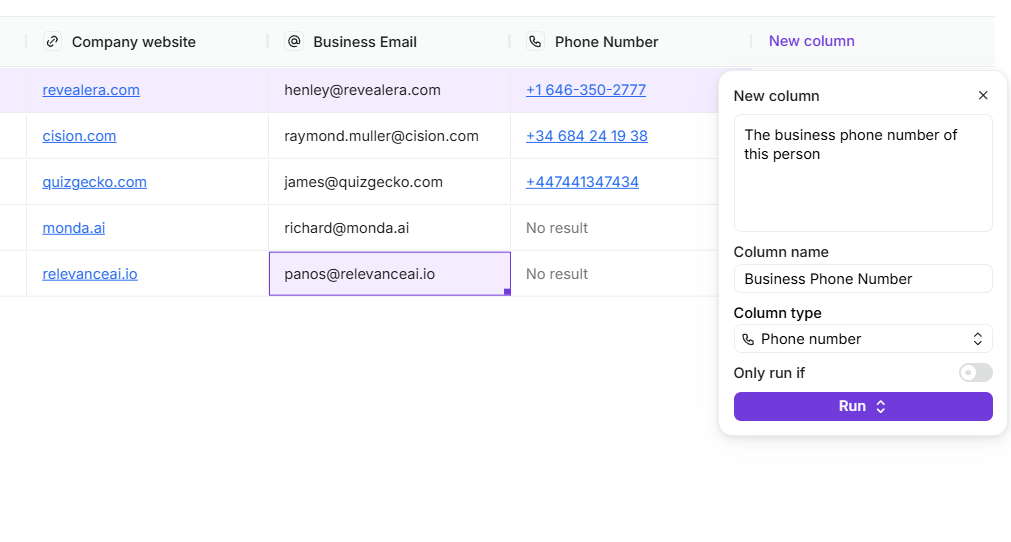
In the screenshot above, I added a column and literally typed “The business phone number for this person”, and Freckle.io was smart enough to know that I wanted the phone number for each row. When I saved and ran this for all the rows, Freckle.io handled the logic of going through their contact data providers to find the phone number for each contact.
I didn’t need to choose which data sources to query, in what order, etc. Freckle.io hides all of that for you, to keep things simple.
What if there’s no data source for what you want?
Even if there’s no data source for what you want, Freckle.io goes out and searches the internet to find the information.
During my trial, I tried adding a column to indicate whether the company website had a security trust center. It enriched each of my rows, and accurately displayed YES or NO in most cases. I imagine they had a web crawler that crawled each company’s website to check.
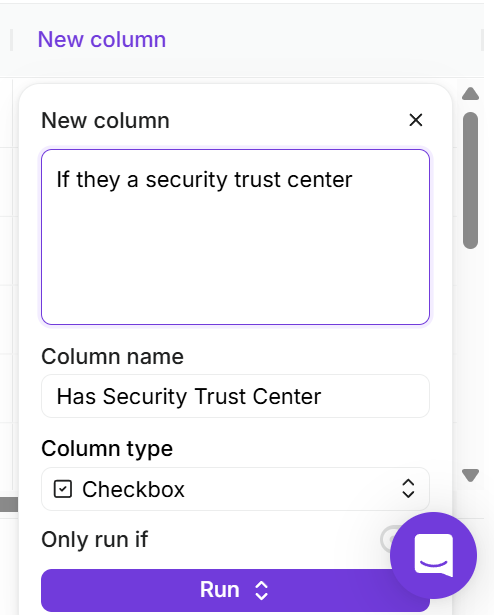
language to describe how you want to enrich it.
Once you’re done with enriching, Freckle automatically syncs everything back to your CRM. This keeps your HubSpot as a single source of truth instead of becoming a messy data mess.
A brief note on their onboarding: I was very impressed with Freckle’s onboarding process. A lot of tools just leave some onboarding video or docs and expect you to learn everything yourself. With Freckle, they have a nice, simple check list. And they even incentivize you with credits for completing each step (smart!)
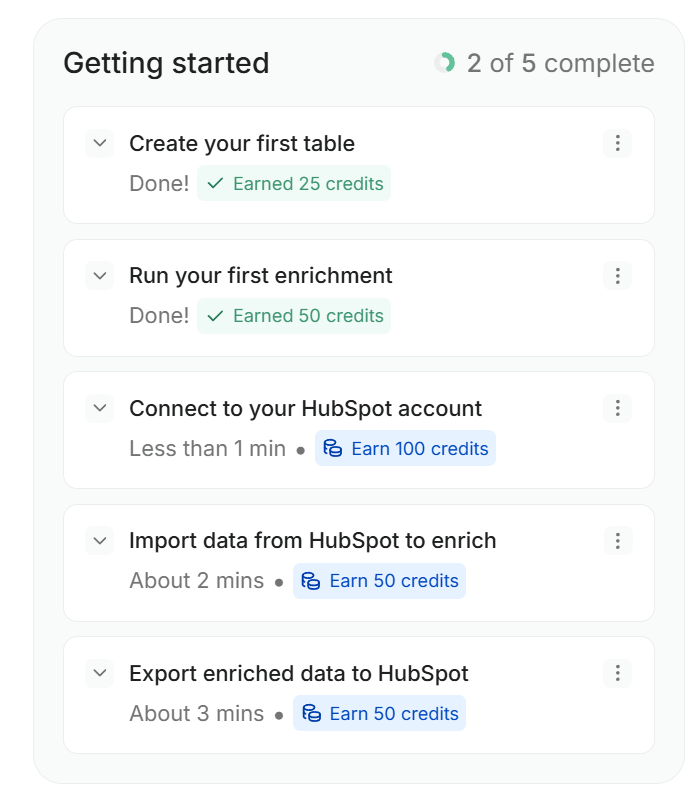
Innovation Score: Very High
Freckle.io ranks very high in terms of innovation and their ability to release new features. In the past 8 months (Feb – October 2025), they’ve added: WhatsApp integration, HubSpot native integration, blur column feature, sentiment analysis capabilities, and company lookalike imports. They’re also moving beyond simple enrichment into automation, scoring and routing.
Based on this pace, it would not be surprising if Freckle.io adds on GTM orchestration and more automation features in the near future.
Limitations
The major limitation of Freckle is their 40 data sources.
Clay, on the other hand has more than 100+ data sources, whether it’s tech stack enrichment with BuiltWith, or simply more email enrichment sources.
Though I had success with their custom columns, it did fail a few times.
For instance, when I added a custom column to indicate whether the company was an UnifyGTM customer, Freckle.io didn’t detect it for 4 of 5 customers of UnifyGTM (it detected it for UnifyGTM itself, which was fairly obvious). I can’t say for certain if more data sources would’ve made them successful, but that’s something to keep in mind.
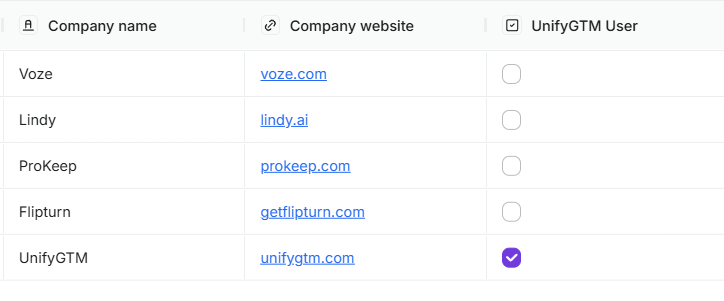
Lastly, they’re Hubspot + Saleforce-focused right now. I couldn’t see any integrations with Salesforce (Update: Freckle.io integrates with Salesforce!), Microsoft Dynamics, Pipedrive or any other CRM. So if you need to sync data from other CRMs, you either need to manually import/export a CSV, or try another tool.
Pricing
In terms of transparency, it’s often difficult to evaluate tools when companies hide their pricing behind a “Call for a Demo.” Freckle doesn’t do that. Their pricing breakdown is clear, so you can quickly decide whether the cost is worth it for your use case.
Freckle offers a generous free tier with 500 credits to get started. After that pricing starts at $99/month for 2500 credits, with phone number enrichments costing 5 credits.
In addition, for the time being, they’re offering any Clay customers to exchange their remaining credits for the equivalent # in Freckle.
| Plan | Price | Credits/Month | Pricing |
|---|---|---|---|
| Free | $0/month | 500 | 1 credit = Email 5 credits = Phone |
| Pro | $99/month | 2,500 | 1 credit = Email 5 credits = Phone |
Freckle’s pricing page: https://www.freckle.io/#pricing
2. Airscale – Best list building and value alternative
Pros: Much less expensive than Clay, robust list-building features.
Cons: Lacks GTM orchestration, inability to try everything out during the trial.
Now on to Airscale.
When I first signed up for an Airscale trial, I liked how simple and easy it was to navigate around. It wasn’t the prettiest UI by any means (definitely not as visually polished as Clay or Freckle), but I appreciate simple UIs.
Right away, after I signed up, I saw 3 tabs: Find people, Find Companies, and Monitor.
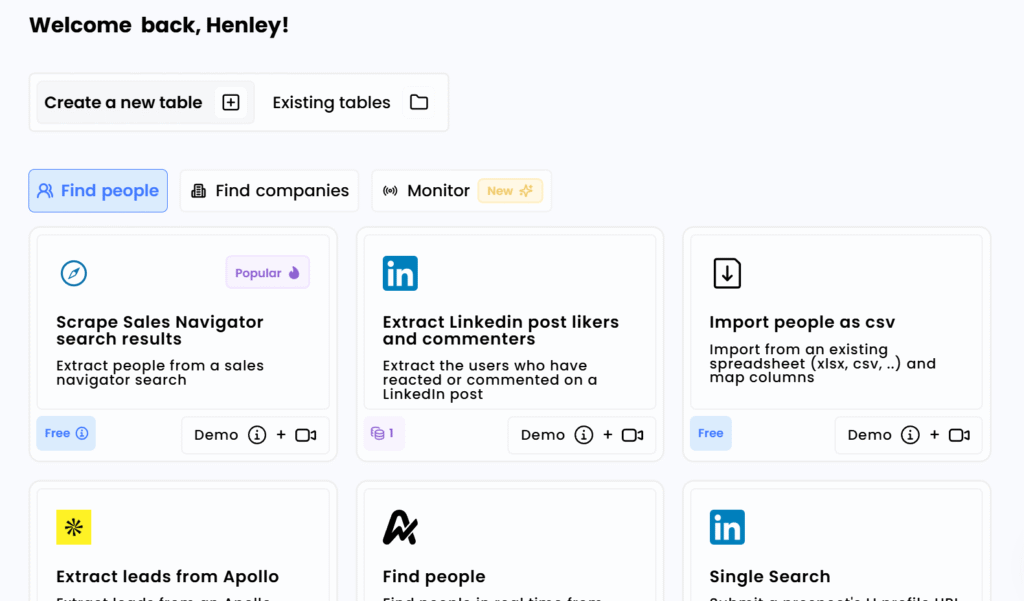
Airscale has more options than Freckle.io for sales prospecting and building your initial list of prospects, and almost as many as Clay. For instance, you can extract Sales Navigator search results directly, scrape LinkedIn post likers and commenters, or extract leads from Apollo.
I tried scraping all the people who liked one of my recent posts as a test, and Airscale handled it just fine. It returned the first and last name, the company they were from, and other details (though I had to pay to enrich all of their emails/phone numbers, as I couldn’t do so during the trial).
Airscale also has a Google Maps scraper that works well for finding local businesses. I searched for ‘financial advisors in the US’, and it returned a list of relevant companies back from Google Maps.
Overall, Airscale is particularly strong at helping you build your initial list.
What about Integrations?
OK, let’s talk about integrations. Airscale claims to have 30 integrations, which is a bit less than Freckle.io.
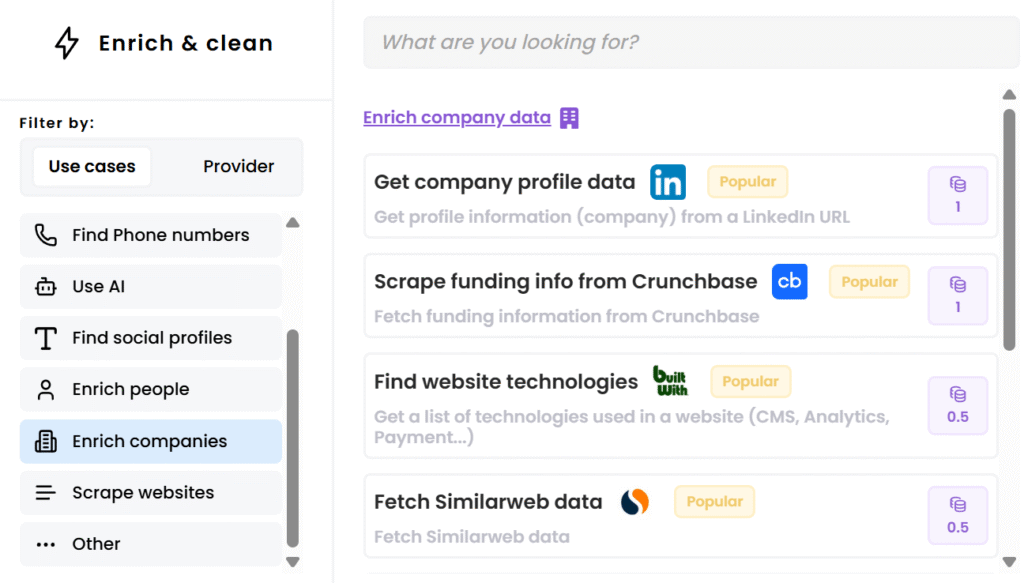
Innovation Score: Very Low
During my review window (Feb – October 2025), I couldn’t detect any major new feature announcements. Their core feature set seems to have remained the same for most of the year: LinkedIn scraping, email finding and enrichment.
Limitations
Not every list building feature worked perfectly. For example, finding companies with a specific job posting did not seem to work at all when I tried it.
When I tried to search for “GTM Engineer”, it showed results like “Market Place Manager” and other seemingly unrelated jobs. I don’t know exactly what Airscale was searching for, but it definitely wasn’t GTM Engineers in this test. If you’re reading this Airscale team, Bloomberry has an API for job postings 🙂
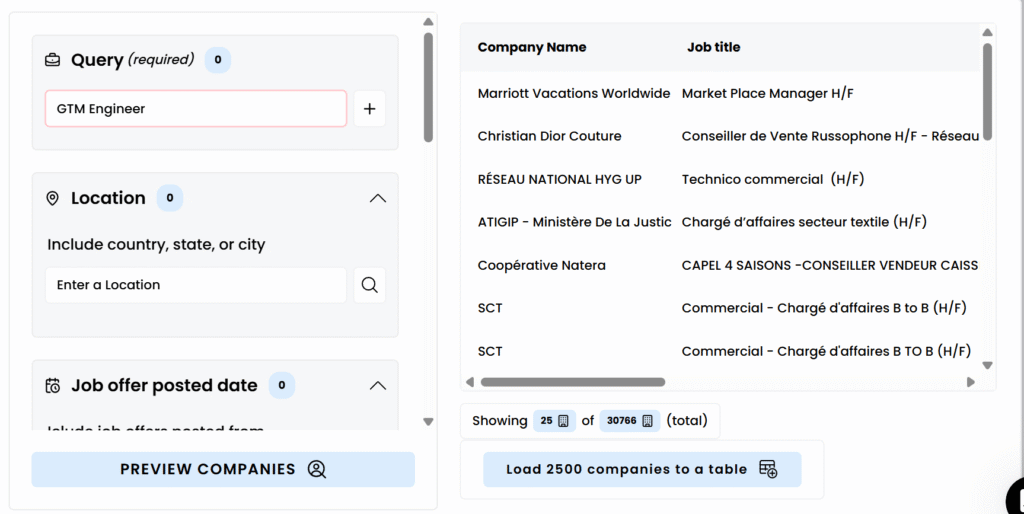
In addition, they only give you a limited number of credits during their free trial. Enriching just 1 contact required a paid subscription. Trying their Company Lookalike feature also required a paid subscription. The free trial felt quite constrained in terms of what I could practically test.
Lastly, I couldn’t spot any integrations with Hubspot, or any other CRM for that matter.
Pricing
Let’s compare the pricing between Airscale and Clay:
At $49 per month for 4,000 credits, Airscale’s cost per credit comes to just $0.01225, whereas Clay charges $149 monthly for only 2,000 credits – a much steeper $0.0745 per credit.
This means that for every $100 spent, users get approximately 8,163 credits with Airscale compared to only 1,342 credits with Clay. In other words, Airscale delivers over six times more credits per dollar than Clay.
With Airscale, when you use their contact enrichment, you only pay when they actually find valid contact information, which is a cost-efficient model. Phone numbers run as low as $0.20 each.
| Plan | Price | Credits/Month | Cost per Credit |
|---|---|---|---|
| Starter | $49/month | 4,000 | $0.01225 |
| Scale | $99/month | 12,000 | $0.00825 |
| Growth | $189/month | 25,000 | $0.0075 |
Note: All plans include unlimited users, credits roll over to next month, access to 30+ data providers, and export to CRMs/sequencers. Credits are used for enrichment actions (specific credit costs per enrichment type not publicly disclosed).
Airscale’s pricing page: https://airscale.io/pricing
3. Exa Websets – easier and simpler to use than Clay
Pros: Easy to use, ability to try everything during the free trial, very fast at releasing new features
Cons: Pricing not as easy to understand, no GTM orchestration, only integrates with Hubspot/Salesforce CRM.
Exa Websets is a relatively new tool that you won’t see recommended in many of the more generic “Clay alternative” articles. But if you’re frustrated with how hard Clay is, then Exa Websets might be right up your alley. It’s very similar to Freckle.io, in that you don’t have to worry about deciding what enrichment source you want to use – you simply use natural language to tell Exa what you want.
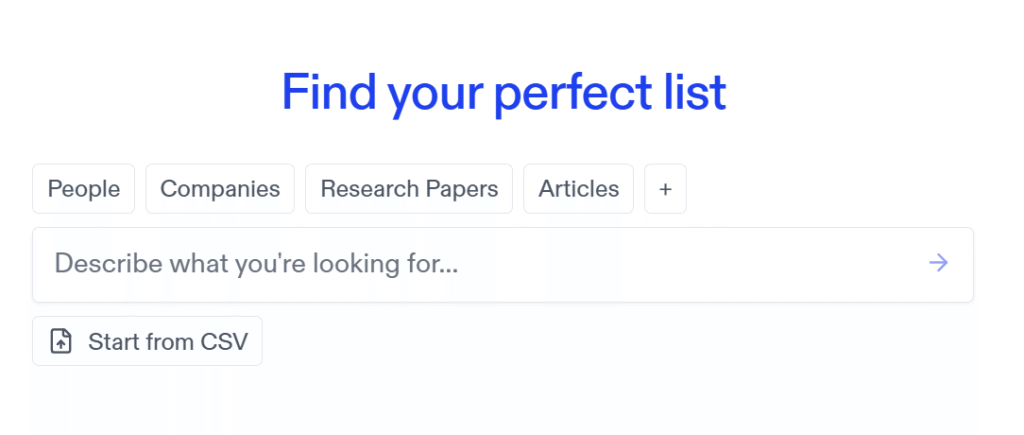
When you sign up to use Exa Websets, you’re greeted with a very simple search bar. You can choose to search for People, or Companies, and all you have to do is enter what you’re looking for in natural language, such as “VP of Sales of fintech startups in NY” or “Fintech startups based in the NYC area”.
After that, Exa generates a spreadsheet (very similar to Clay) that will slowly go out and retrieve what you’re looking for. You can also add enrichment columns. If you don’t find any that match what you’re looking for, you can just describe it and Exa will intelligently determine which data source to get it from.
During my trial, I searched for companies that were “SaaS companies of GTM tools and companies”, and enriched them with the CEO LinkedIn url, the company’s estimated revenue, and the outreach tool they used. The list of companies they returned back, and the enrichments, for the most part, matched what I was looking for.
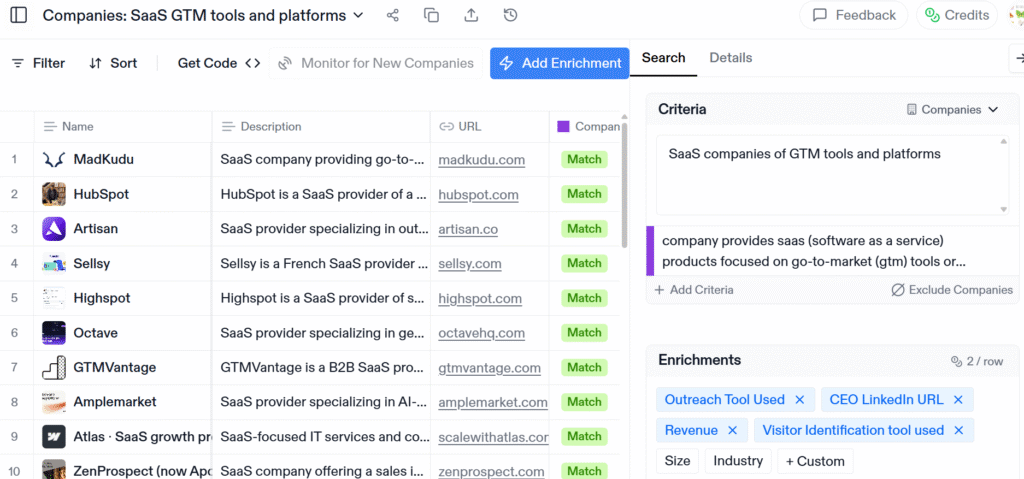
However, when I searched for people, it was a bit hit and miss. I searched for “Head of Partnerships in GTM Tools”, with work email and phone numbers as enrichment columns.
Exa then generated a list that looked solid at first glance, but once I delved into the people, a small number of them were people who had recently changed jobs (no longer holding the title of Head of Partnerships). Most of them were people who changed jobs within the past month. I imagine Exa probably doesn’t refresh their LinkedIn people database every single day, which is understandable, so you might have to live with a few inaccuracies.
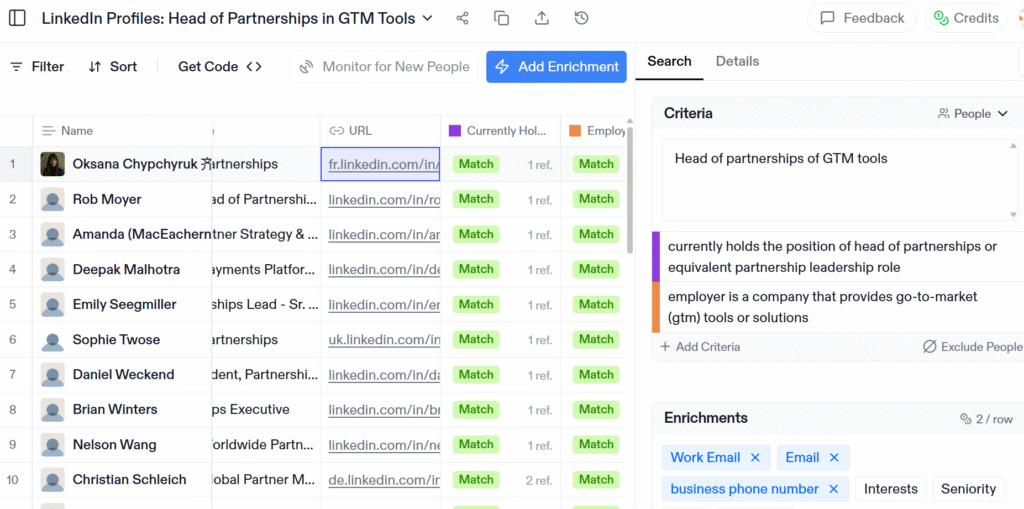
Exa did do a good job of retrieving phone numbers and business emails for most of the contacts, and most of them were correct.
Innovation Score: Very High
Exa releases new features almost every week, and technically impressive ones too. In the past year, they’ve developed a custom transformer model, a proprietary vector database (for searching companies), multiple AI models (Exa Fast, Exa Deep, etc) and more.
Limitations
Exa Websets doesn’t come with any signal-based orchestration. For example, you can’t have it monitor all of your people results to alert you when someone has changed their jobs. Nor can you monitor all of your company results to alert you when one of them has posted a job posting for a certain job title. Exa Websets is mostly for simple data enrichment.
Pricing
Exa’s pricing can be a bit hard to understand and a tad pricey. For starters, they charge 10 credits for each result that matches your query. This doesn’t even include any special enrichments (except for the standard ones they provide for every company/person). So right off the bat, if your query generates 100 people, that will cost you 1,000 credits.
Emails and phone numbers each count 5 credits, and all other enrichments cost 2 credits each.
| Plan | Price | Credits/Month | Credit Costs |
|---|---|---|---|
| Free | $0/month | 1,000 | 10 credits = 1 matching result 5 credits = Email or phone |
| Core | $49/month | 8,000 | 10 credits = 1 matching result 5 credits = Email or phone |
| Pro | $449/month | 100,000 | 10 credits = 1 matching result 5 credits = Email or phone |
| Enterprise | Custom | Custom | 10 credits = 1 matching result 5 credits = Email or phone + Volume discounts |
Note: You only pay 10 credits for results that match all your search criteria. Results that don’t match all criteria cost 0 credits. Email and phone enrichments cost 5 credits each, regardless of plan.
Exa’s pricing page: https://exa.ai/websets/billing
4. Hubspot Breeze Intelligence – Best for company enrichment if you already use Hubspot
Pros: Relatively inexpensive for existing Hubspot users
Cons: Only does company enrichment, not contact enrichment
If you’re already paying for Hubspot, and only need company enrichment, Breeze Intelligence might be a good fit. They even do basic company enrichment for free. By basic company enrichment, I mean fields like annual revenue, # of employees, industry, keywords related to the company, etc.
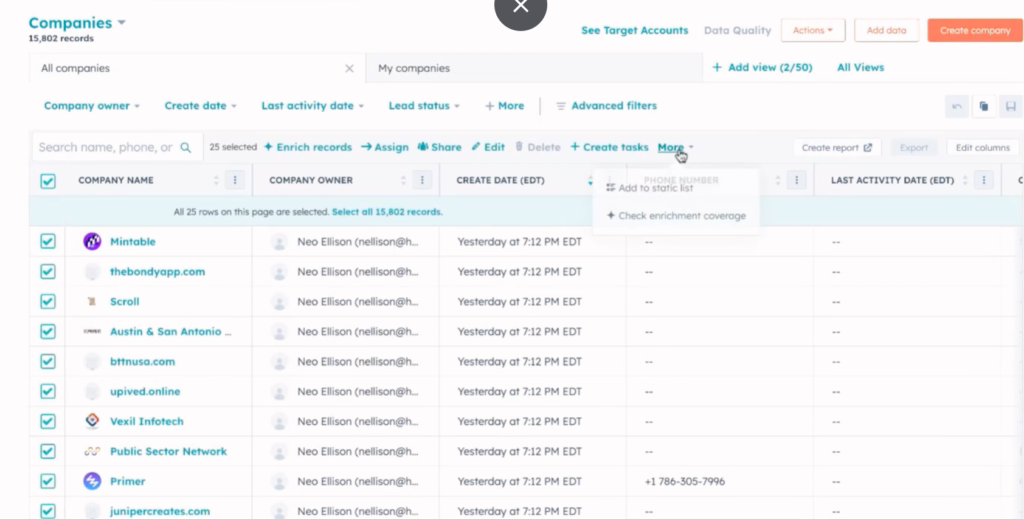
Basic company enrichment is pretty simple. Just choose the records you want within your list of companies, choose “More” and “Check enrichment coverage”. Hubspot will then go through all those companies and tell you what % of them they can enrich for you.
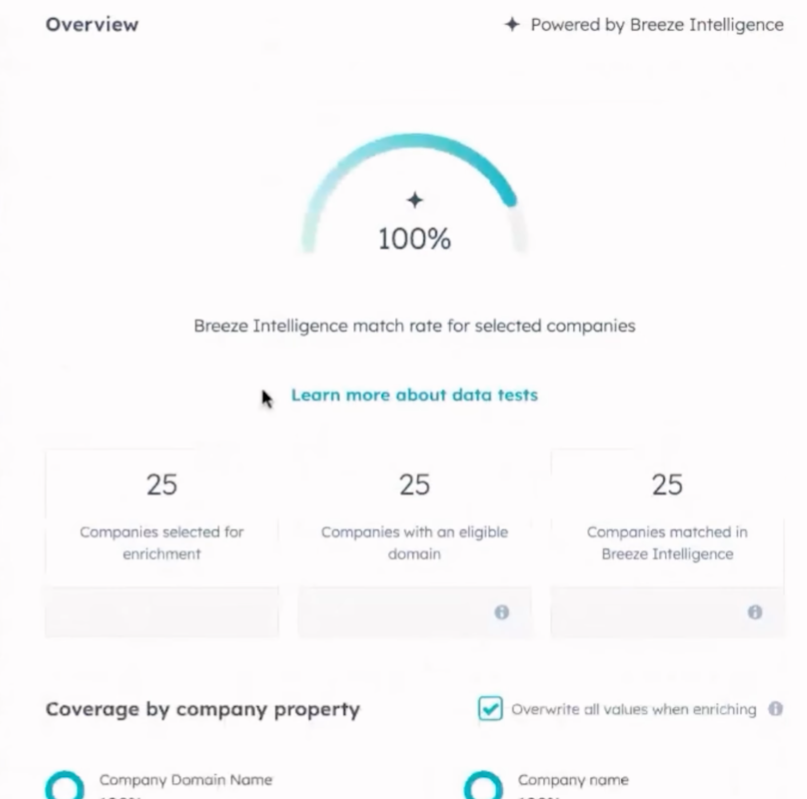
When I selected 25 companies in my CRM, Hubspot told me that all 25 had an eligible domain and could be enriched. When I pressed “Enrich” it populated basic info about each company as you can see below.
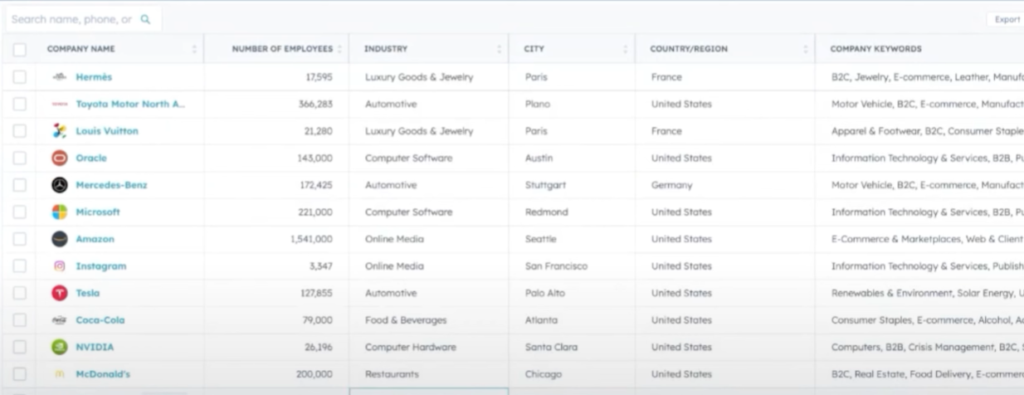
Hubspot also released a new feature called “Smart Properties” which is basically their version of Clay’s Claygent. It lets you create custom AI-powered fields that automatically populate based on a prompt you write. For example, you could create a Smart Property that determines a company’s target customer, identifies what services they offer, or figures out their tech stack – all by having the AI search public web data.
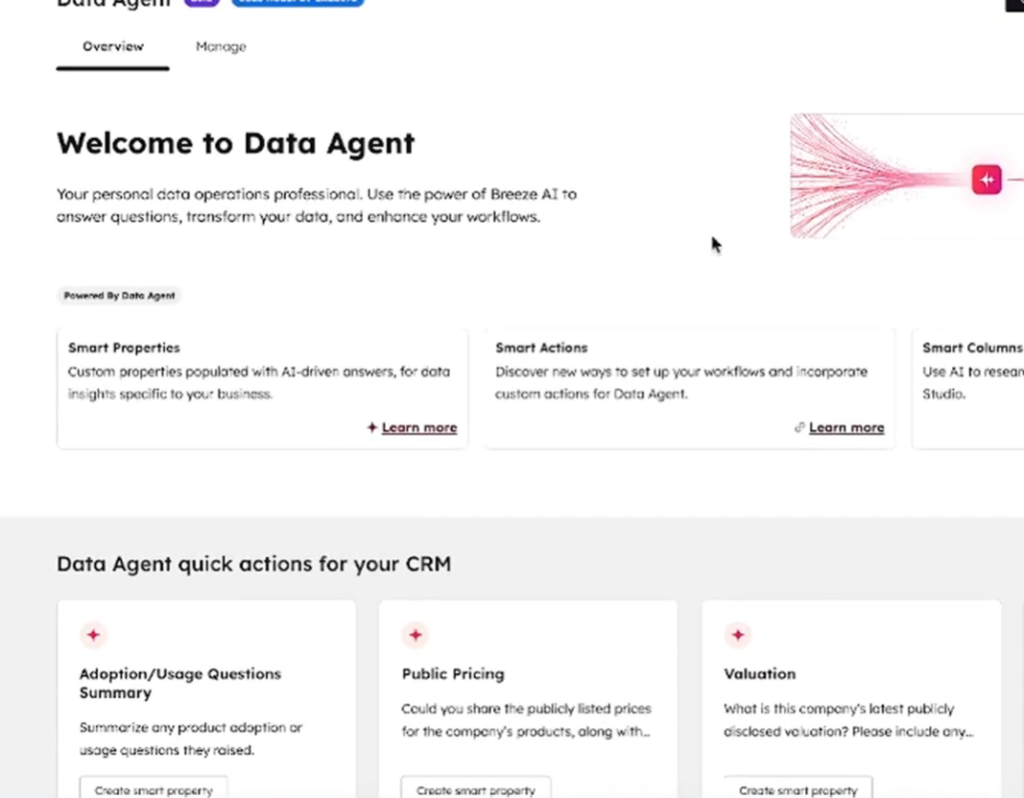
In addition to searching public web data, it can also pull from data you already have in HubSpot, like existing properties or even call transcripts if you’re using HubSpot for calls. So you could set up a prompt like “based on the last 5 call transcripts, summarize this prospect’s main objections” and have that auto-fill into a property on the contact record. It’s essentially letting you build custom enrichment without needing a separate tool.
The workflow integration is where it gets interesting for automation. You can use the Data Agent to fill Smart Properties as a workflow action, so when a new company enters your CRM or hits a certain lifecycle stage, it automatically runs the AI enrichment.
You can also set up scheduled auto-fills (daily, weekly, or monthly) on specific segments of your database. Each Smart Property fill costs 10 HubSpot credits per record, so it’s not free, but it’s all native inside HubSpot without needing to connect multiple external tools.
Limitations
Here’s where my testing hit a wall: Breeze Intelligence doesn’t enrich phone numbers or email addresses. I specifically tried enriching several contact records hoping to get mobile numbers or even just direct dials, and nothing came back for those fields.
This is a major limitation if you’re doing cold outreach or building prospect lists from scratch. You’re basically enriching around the contact info rather than getting the contact info itself, which is a mismatch for sales teams who rely on those phone numbers and verified emails to actually reach people.
In addition, one limitation with their custom AI enrichment: if you’re trying prompts that attempt to scrape LinkedIn, these enrichments get filtered out and won’t return values, so you can’t use it to check LinkedIn job postings or pull LinkedIn profile data the way you could with Clay. I imagine it’s because of legal reasons as they don’t want to scrape Linkedin.
Pricing
The pricing is actually pretty reasonable if you’re already a HubSpot customer. Users on Starter, Professional, or Enterprise plans don’t consume credits for basic data enrichment – it’s essentially included. Breeze Intelligence credits are sold in packs: 100 credits for around $30/month, 1,000 credits, or 10,000 credits for larger operations. Each record enrichment costs one credit.
| Credit Pack | Monthly Cost | Cost Per Credit | What It Gets You |
|---|---|---|---|
| 100 Credits | $30/month | $0.30 | ~100 standard enrichments ~10 Smart Property fills ~10 Buyer Intent companies |
| 1,000 Credits | $150/month | $0.15 | ~1,000 standard enrichments ~100 Smart Property fills ~100 Buyer Intent companies |
| 10,000 Credits | $700/month | $0.07 | ~10,000 standard enrichments ~1,000 Smart Property fills ~1,000 Buyer Intent companies + Continuous enrichment included |
| Bulk Backfill | $5,000 one-time | ~$0.005 | Up to 1 million records One-time enrichment Limited-time offer |
5. Persana AI – Best for Signal-Based GTM Orchestration
Pros: Has GTM orchestration, easy to use
Cons: Can’t try out anything without a demo, non-transparent pricing, only supports Hubspot/Salesforce CRMs
If you need more than simple data enrichment, then Persana AI might be a good alternative – it’s a full-blown orchestration platform.
Like Clay, and the other aforementioned tools, once you log into the platform, you have the option to create a lead list from scratch, or import a CSV of leads you want to enrich.
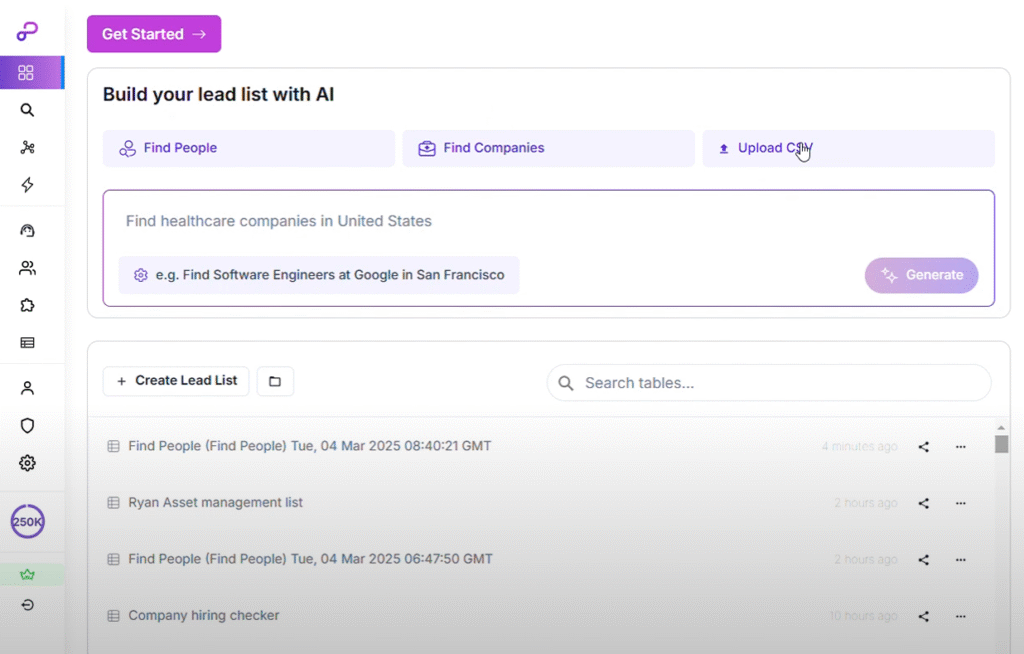
If you want to build your own lead list, you can use natural language to describe the people or companies you want, such as “Find all healthcare companies in the United States”. Alternatively, you can just use standard filters instead.
Persana also has something called Persana Quantum Agent (their own version of Claygent). You can describe exactly what you want the agent to try and retrieve such as “Visit the website of the company, then identify the most advanced features they offer and how it differs from the basic features available”.

All of this seems pretty standard so far.
OK, let’s talk about what differentiates Persana from tools like Freckle, Airscale and Exa Websets: signals and signal orchestration.
Persana has over 75+ different signals (ie job changes, hiring trends, funding, website visits) already integrated into the platform.
You don’t need to manually add columns for each signal either. Persana automatically tracks them in the background. After you create a table, Persana alerts you automatically when someone changes jobs or their company starts hiring, for instance.
In addition, instead of manually monitoring signals, you can also turn on Autopilot, which watches for these triggers and automatically takes action when the timing is right.
Most users integrate Persana with dedicated email sequencers like Instantly or Smartlead to handle the actual sending, while some use Persana’s native email capabilities. You can also configure Autopilot to update your CRM or send alerts to Slack. The workflow is really flexible depending on your existing tech stack.
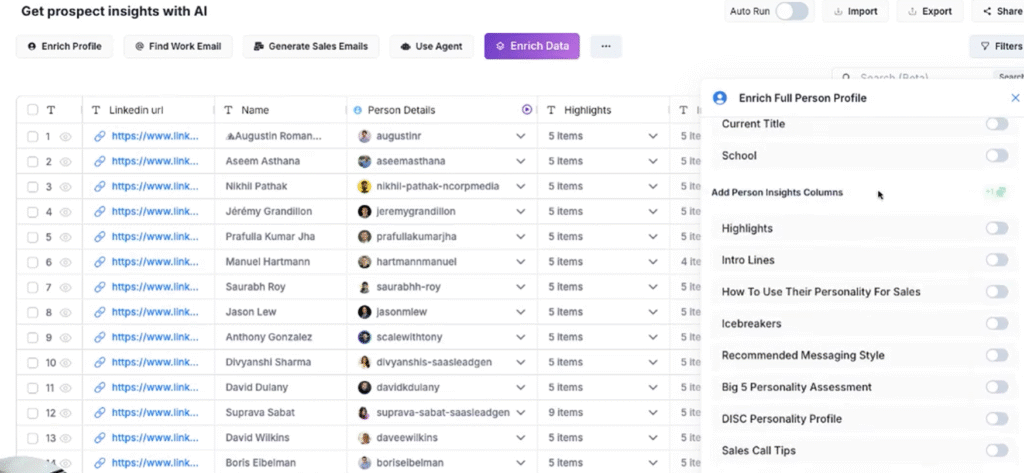
Another of Persana’s notable features is their “Enrich Full Person Profile” enrichment. The results were surprisingly useful when I tried it.
What I did was import a bunch of Linkedin URLs of people I was interested in contacting, then click “Enrich Profile” to activate the AI enrichment.
Persana then generated columns like “highlights” (career achievements), “intro lines” (AI-generated conversation starters), “”how To use their personality for sales” (tactical selling tips), “Icebreakers” and more. This is convenient for crafting the right outreach message to these prospects, and something I didn’t see in Freckle or Airscale.
If you prefer a tool where a lot of things are configured for you, Persana is a better tool for you than the more DIY-style enrichment platforms.
Innovation Score: Medium
Persana releases new features on a regular cadence – not as fast as Exa, but definitely not slow either. Major launches in the past year included: Quantum Agent, AI SDR agents (Perry, Nia, Alex), Waterfall Enrichment, Vibe GTM, SalesGPT 2.0, ABM Tracking, GPT-5 integration.
One thing that lowers their score here is that there doesn’t seem to be anything particularly technically novel that stands out relative to the rest of the market. They integrate a lot of data sources, and have an AI agent, but there’s nothing I could see that clearly indicates it is more advanced than what other competitors are using.
Limitations
If there’s one thing I found challenging about Persana it’s that credits burn faster than you’d think. Finding one phone number = 10 credits, so you need to be strategic about what you’re enriching. That and you need to go on a demo to actually get a chance to try the platform – there isn’t a self-serve option.
Most people who use Persana also require an email/contact sequencer like Instantly or SmartLead, as Persana doesn’t yet have a fully mature platform for sending at scale.
Pricing
Persana’s pricing page: https://persana.ai/pricing
| Plan | Price (Annual) | Credits/Year | Credit Costs |
|---|---|---|---|
| Free | $0/month | 50-100 | 1 credit = Email enrichment 10 credits = Phone number |
| Starter | $68/month ($85 monthly) | 24,000 | 1 credit = Email enrichment 10 credits = Phone number |
| Growth | $151/month ($189 monthly) | 60,000 | 1 credit = Email enrichment 10 credits = Phone number |
| Pro | $400/month ($500 monthly) | 216,000 | 1 credit = Email enrichment 10 credits = Phone number |
| Unlimited | $600/month | 600,000 | 1 credit = Email enrichment 10 credits = Phone number |
| Enterprise | Custom | Custom | Custom pricing available |
Note: All paid plans include unlimited users and credits roll over to the next month (up to 2x your monthly limit). Save 20% with annual billing.
6. Floqer – Also good for Signal-based GTM Orchestration
Pros: Has GTM orchestration, easy to use
Cons: Lack of transparent pricing, and can’t try everything unless you have a demo.
Floqer is very similar to Persana, and another platform that attempts to orchestrate your entire GTM workflow.
Floqer’s first core feature is CRM enrichment and cleaning. So, if you have contacts with missing data like emails or phone numbers, Floqer uses a waterfall enrichment to find those emails/phone numbers. During my trial, I intentionally removed emails and phones for 10 of my contacts in Hubspot, and Floqer was able to repopulate 9 of them. I used Hubspot, but Floqer integrates with most of the other major CRMs like Salesforce.
Beyond cleaning, Floqer also updates your stale data. For example, it keeps monitoring your contacts for job changes. If someone moves to another company, it updates their company, email, and job title automatically.
What if you don’t have any contacts or you don’t even use a CRM? That’s where their list building comes into play. Floqer helps you find NEW prospects by using intent signals. They have an entire section devoted entirely to “Intent Signals”, where you choose templates like “companies hiring aggressively” or “new executives hired.”
During my trial, I decided to give their “Track job postings” a try, and searched for companies that posted a job posting for a CRO. I got back 20 companies and the list updates every day as new companies match the criteria.
Sometimes you need prospects that aren’t in any database though. That’s where their AI agents come into place. During my trial, I found a URL that had a list of some companies that were presenting in Salesforce’s DreamForce convention. When I pasted the URL into their scraper, and wrote “get company names and booth numbers”, Floqer’s agent went out and extracted 50+ exhibitors in two minutes.
There were a few times their AI agent struggled or didn’t completely extract everything. For instance, when I pasted a list of stores in the Faire Marketplace, it had trouble paginating through all of them. But for the most part, I was impressed with how intelligently it was able to scrape the fields and rows I needed.
The last thing that Floqer offers is workflows that chain everything together. I built a workflow that says: when “New CRO” signal fires, enrich that person to get their contact info, check if their company has more than 100 employees, and if yes, kick off an email sequence. Intro email, wait 3 days, follow-up if no reply, LinkedIn connection request.

One thing to note is that Floqer doesn’t send the actual email or Linkedin request itself. It just helps you build that workflow. Instead it integrates with a sequencer like Instantly, where the actual messages get sent.
Innovation Score: Low
During the 8-month window I checked, I couldn’t detect any clearly announced new features, so I’m giving them a relatively low innovation score. They seemed to have pivoted from being an email personalization platform to a full-fledged GTM orchestration platform.
Limitations
The platform has 80 data providers versus Clay which has 150+. For standard B2B emails and phone numbers I didn’t notice a major gap. If you need niche data though, like podcast appearances or GitHub activity, or deep technographics, the narrower options might matter.
Pricing
Floqer doesn’t publish pricing. I had to get on a call with sales to get a quote. They said credits cost 20-30% less than competitors per enrichment, but I couldn’t independently verify that.
7. Apollo – Best for All-In-One Platform
Pros: Easy to use, has GTM orchestration and engagement, can test everything before paying, supports Hubspot, Pipedrive, Salesforce and many more CRMs
Cons: More expensive than the other options
Apollo.io goes beyond both Persana and Floqer, and provides everything to you, from prospecting, enrichment, and outreach. It’s an all-in-one platform that is meant to replace Clay, signal data providers, and outreach tools.
Using enrichment in Apollo is straightforward: I upload a CSV of contacts or companies, and Apollo enriches it with emails, phone numbers, job titles, and company data from their database.
The CRM integration is where it gets really useful. I was able to connect Apollo to my Salesforce account and set up automatic enrichment rules. Now when a new lead enters my CRM with incomplete data, Apollo automatically fills in missing contact details in real-time.
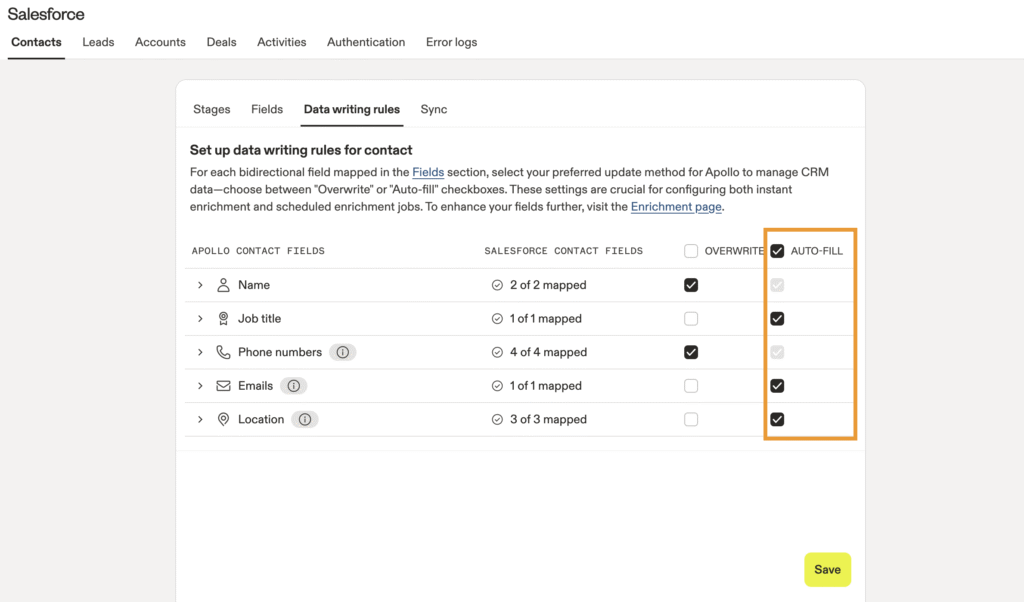
It used to be that Apollo didn’t do waterfall enrichment, but that changed recently a few months ago. Before, you were limited to Apollo’s database. Now you can set up a waterfall that tries Apollo first, then falls back to other providers like Prospeo, ZoomInfo, or Lusha if Apollo doesn’t have the data.
I tested this by enriching a list where Apollo only found 60% of emails. I then setup a waterfall with Prospeo as the backup provider. The match rate jumped to 82%. You connect your own API keys for the backup providers, so you’re paying those providers directly, not Apollo.
Apollo’s prospecting is really robust as well. Clay doesn’t have a native database – you’re building lists from scratch or importing them. Apollo, on the other hand has 275M contacts and 73M companies built in, so I can search directly inside the platform.
During my trial, I wanted to find VPs of Sales at SaaS companies with 50-500 employees. I used Apollo’s filters for job title, industry, company size, tech stack (like “uses Salesforce”), and funding stage, and got back 3,400 results. You can filter by specifics like “companies hiring in the last 30 days” or “uses HubSpot but not Outreach.”
The intent data filters are useful too. I can find companies showing buying signals like recent funding rounds, job openings, or technology changes. It’s not as deep as dedicated intent platforms, but it’s built right into the prospecting interface instead of needing a separate tool.
What you also get with Apollo is the seamless workflow from enrichment to outreach. Let’s say I just enriched 500 contacts with emails and phone numbers. I can immediately select those contacts, enroll them in an email sequence, and Apollo tracks opens, clicks, and replies all in one dashboard.
In addition, they also have a built-in dialer for cold calling and LinkedIn connection/messaging automation.
If you prefer simplicity and like the idea of consolidating multiple tools into one, Apollo is designed for that type of workflow. They handle prospecting, waterfall enrichment, and outreach sequencing and execution, so you don’t need to juggle multiple tools.
Innovation Score: Medium
Apollo.io ranked average in innovation. Major launches in the past 8 months included: AI Power-ups, Workflows (replacing Plays), Win Deals solution, Ask Apollo chatbot, Waterfall Enrichment (this is the big one), and an improved deliverability suite.
They’ve released some solid, incremental improvements recently, but I wouldn’t categorize any of it as “groundbreaking”.
Limitations
While Apollo has waterfall enrichment, it’s not as flexible as Clay’s data orchestration. Here are some examples of things you can’t do (as of today):
- Customize your waterfall sequence or choose which providers to use in what order (Apollo decides for you)
- Build conditional enrichment logic (“if company has 50+ employees, use ZoomInfo; if less, use Apollo”)
- Chain together multiple data sources creatively (LinkedIn data + Clearbit firmographics + AI scoring + Apollo contacts)
- Use custom formulas or transformations to parse and manipulate data
- Build complex multi-step enrichment workflows with branching logic
If you need pure data enrichment flexibility with full control over your waterfall logic and data transformations, Clay is still the more configurable choice.
Pricing
Apollo offers a freemium model – I started for free with limited credits, then paid plans start around $49/month for basic enrichment. They use a credit system where different data points cost different amounts of credits.
Apollo’s pricing page: https://www.apollo.io/pricing
| Plan | Price (Annual) | Price (Monthly) | Credits/Month |
|---|---|---|---|
| Free | $0/user/month | $0/user/month | Unlimited email credits 5 mobile credits 10 export credits |
| Basic | $49/user/month | $59/user/month | Unlimited email credits 50 mobile credits 500 export credits |
| Professional | $79/user/month | $99/user/month | Unlimited email credits 100 mobile credits 2,000 export credits |
| Organization | $119/user/month | $149/user/month | Unlimited email credits 200 mobile credits 4,000 export credits (Min 3 users) |
Credit Breakdown:
- Email credits: Unlimited on all plans (subject to fair use policy)
- Mobile credits: Used to reveal verified phone numbers
- Export credits: Used when exporting contacts to CRM, CSV, or external tools
- Additional credits: $0.20 each (min purchase: 250 monthly or 2,500 annually)
- Credits expire: All unused credits expire at end of billing cycle (no rollover)
8. FullEnrich – Best for Contact Data Waterfall Enrichment
Pros: Easy to use, free trial lets you try everything, reasonable pricing
Cons: Only specializes in contact enrichment, Only supports Hubspot CRMs
Unlike all the other tools I tried so far, FullEnrich does only 1 thing and focuses on doing it very well: waterfall contact enrichment across 15+ data providers. So if you simply need to get the most accurate emails and phone numbers possible FullEnrich is a strong option.
FullEnrich aggregates contact data from providers like Apollo, Hunter, Lusha, and more, running them sequentially until it finds a match.
When I tested it, the email match rates were noticeably higher than using any single provider alone. And it was very easy to use. I simply uploaded a CSV with names + companies, and FullEnrich enriched it with contact data, spitting out a CSV back I could download.
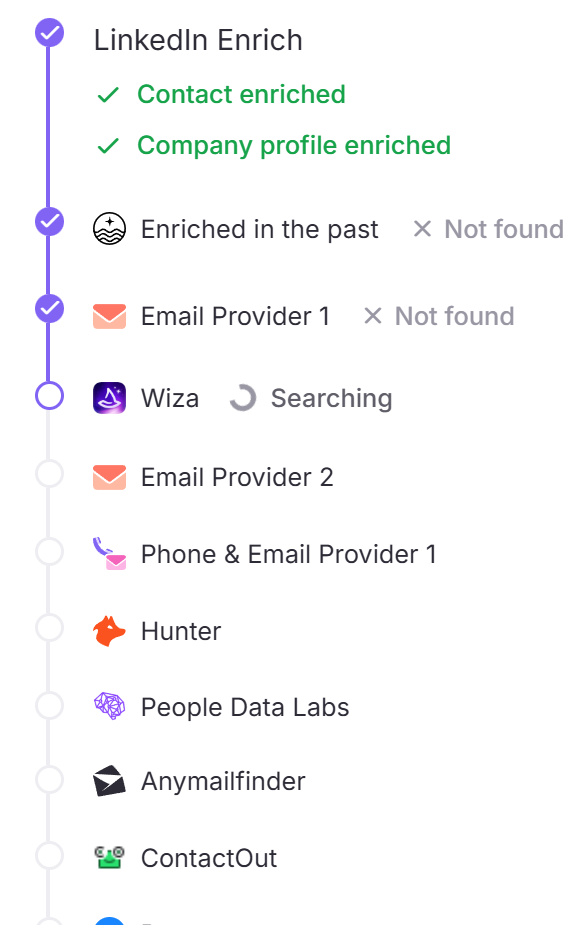
In my test of 4 contacts, FullEnrich successfully found and verified emails for 3 out of 4 (75% match rate, and that one miss was because they detected a catch-all email), with clear verification indicators next to each email address.
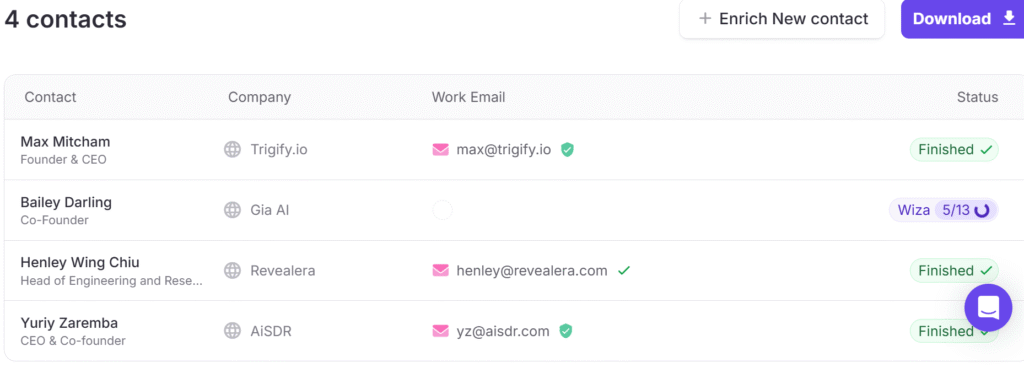
Innovation Score: High
In the past 8 months, FullEnrich has released a solid amount of new features: a Chrome extension, V2 launch, a Clay integration, and an n8n integration. For a small team (40 or so employees), this is fairly impressive.
They seem to be very responsive to user feedback, as they released a Clay integration because it’s something a lot of their users asked for.
Limitations
FullEnrich is mostly a contact enrichment tool, so it won’t help you build lists, create workflows, or automate outreach. If you need those capabilities, you’ll need to pair it with other tools.
The lack of native CRM integrations is another limitation. You’re working with CSV uploads and downloads, which means manual work if you want to sync data back to Salesforce or HubSpot.
But if your only focus is enriching a CSV with contact data, FullEnrich is probably the best tool for that specific use case.
Pricing
FullEnrich offers transparent, credit-based pricing.
FullEnrich’s pricing page: https://fullenrich.com/pricing
| Plan | Price (Monthly) | Price (Annual) | Credits |
|---|---|---|---|
| Free Trial | $0 | $0 | 50 credits |
| Starter | $29/month | $26/month (~30% discount) | 500/month (monthly) 6,000/year (annual) |
| Pro | Custom | Custom | Custom allocation |
| Scaleups & Agencies | $400-$50,000/month | Custom | Custom high-volume packages |
Credit Breakdown:
- 1 credit = 1 email found
- 10 credits = 1 phone number found
- Credit rollover: 3 months (monthly plans), 6 months (one-time), 12 months (annual)
- Pay-per-result: Only charged when data is successfully found
- Unlimited users: All plans include unlimited team members
- Waterfall enrichment: 15+ data providers for 80%+ find rate
9. Cognism – Ideal for contact data for European companies
Pros: Excellent European contact data, supports a lot of CRMs beyond Hubspot/Salesforce
Cons: Only specializes in contact data, no transparent pricing, need a demo to try it out
Cognism is another tool like FullEnrich that specializes mostly in contact data enrichment, but their specialty is European markets.
Like FullEnrich, their user interface is also really simple. I simply upload a CSV of contacts or companies, and Cognism enriches it with verified emails and phone numbers.
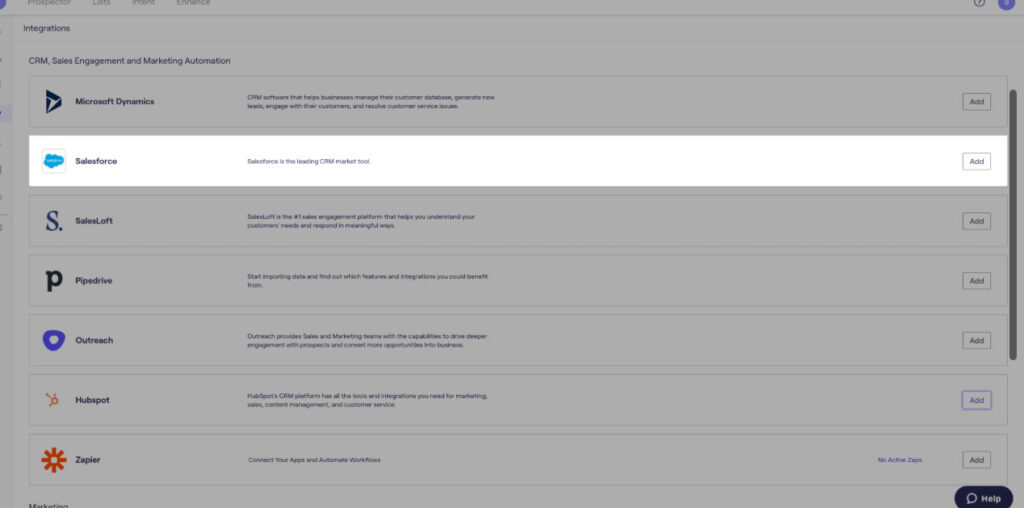
Unlike FullEnrich though, you’re not just limited to CSV files. As you can see in the screenshot above, they offer integrations to many CRMs like Salesforce, so that it can enrich your records automatically.
During my trial, I connected Cognism to my Salesforce account and set up automatic enrichment rules. When a new lead entered my CRM with incomplete data, Cognism automatically filled in missing contact details in real-time.

What makes Cognism stand out is their phone-verified mobile numbers – they actually have real people calling to verify contact information, which means higher accuracy rates than most providers. This helps ensure you’re not wasting time on outdated or incorrect numbers.
Innovation Score: Average
Cognism seemed to have just one major feature in the past year: Sales Companion, which is an AI-powered sales assistant that provides insights and research. Other than that, I couldn’t find much else that was new. I got the sense that they spend a lot more time in marketing, holding events, and building their community (which has its own advantages).
But in terms of raw product innovation, my impression was that they’re roughly average.
Limitations
Unlike FullEnrich, Cognism is a single data source. I’m querying their proprietary database – either they have the contact info or they don’t. While FullEnrich aggregates data from 15+ providers to maximize coverage, Cognism bets on the quality and verification of their own dataset, particularly for European contacts.
Also, while it may sound obvious, Cognism is not a full-blown Clay replacement. They specialize mostly in European contact data. If that’s what you want though, then Cognism is a strong candidate.
Pricing
Cognism’s pricing isn’t transparent, so you’ll need to request a custom quote, which can be frustrating if you’re trying to budget or compare options quickly. The platform also tends to be on the pricier side, making it less accessible for smaller teams or startups.
10. DIY Approach with Google Sheets, N8N and Apify
If you prefer a DIY approach and aren’t afraid of some setup work, you can implement your own Clay-like system with inexpensive tools.
As an example, I decided to build my own lead gen system from scratch using N8N, Google Sheets, and various APIs. This isn’t some half-baked hack either. I built a fully automated system that scrapes leads, enriches data, finds emails, and even drafts personalized outreach – all on autopilot.
What This System Does
Here’s what I managed to automate:
- Scrapes 250+ leads/day from LinkedIn Sales Navigator
- Enriches every contact with AI-generated company descriptions and website URLs
- Validates emails using a two-layer waterfall (Prospeo → Scrap.io)
- Writes custom outreach using GPT based on enriched data
- Logs everything in Google Sheets with a clean, spreadsheet-style interface
The Tool Stack
Here’s what I used to build it:
- N8N – The automation brain (free, self-hosted)
- Google Sheets – My makeshift CRM
- Apify – For LinkedIn Sales Navigator scraping
- Perplexity AI – Generates company context and finds websites
- Prospeo + Scrap.io – Email waterfall enrichment
- OpenRouter (GPT) – Auto-drafts personalized emails
Total cost? Primarily API credits. No large monthly SaaS subscriptions.
How It Works
Step 1: Scrape Targeted Leads From LinkedIn Sales Navigator
I use Apify’s LinkedIn Sales Navigator scraper to pull leads based on my ICP (job titles like CEO/Founder/CMO, company size 11-50, SaaS industry, etc.).
The scraper grabs:
- First and last name
- Job title
- Company name
- LinkedIn URL
This data flows directly into Google Sheets with a status of “Pending Enrichment.”
Step 2: Enrich Each Company With AI
Next, N8N triggers a daily workflow that:
- Pulls companies from Google Sheets where the description/website is empty
- Sends the company name to Perplexity AI with the prompt: “Find the official website and 1-sentence description for [company name] in [location]”
- Parses the AI response and updates the sheet automatically
Now I have context on every company without manually researching them.
Step 3: Email Enrichment Waterfall
Here’s where it gets good. I set up a two-layer email waterfall:
First layer: Prospeo
N8N calls Prospeo’s API with first name, last name, and domain. If Prospeo finds a verified email, it saves it to the sheet.
Second layer: Scrap.io (fallback)
If Prospeo fails, the workflow automatically falls back to Scrap.io with the same parameters. This significantly increases my match rate.
The sheet now shows:
- Email address
- Email status (Valid/Invalid/Not Found)
Step 4: Auto-Draft Emails Using GPT
For contacts where I found an email, N8N triggers an OpenRouter GPT node with this prompt:
“Write a 2-line personalized cold email to {firstName} {jobTitle} at {companyName}. Use this company description: {description}. Keep it casual, no links, max 100 words.”
GPT drafts the email and appends it to a new column in Google Sheets.
The Results
I now have a self-updating database that:
- Scrapes 250+ qualified leads daily
- Enriches company info automatically
- Finds verified emails via waterfall
- Drafts personalized outreach
All on autopilot.
Pricing
This is where the DIY approach shines:
- N8N: Free (self-hosted) or $20/month (cloud)
- Apify: ~$0.10 per 100 leads scraped
- Perplexity API: ~$0.002 per enrichment
- Prospeo: ~$0.02 per email found
- Scrap.io: ~$0.01 per email lookup
- OpenRouter (GPT-4): ~$0.01 per email draft
For 5,000 leads/month enriched with emails and AI-drafted outreach, I’m spending roughly $150-200 in API costs. Compared to Clay’s $800+/month for similar usage, the DIY stack can be significantly cheaper if you’re comfortable with setup and maintenance.
Limitations
To be transparent – this isn’t plug-and-play:
- Setup time: It took me about 4 hours to build and test all the workflows
- Technical skills needed: You need to understand APIs, N8N workflows, and basic scripting
- Maintenance: Occasionally APIs change or break, and you need to fix them yourself
- No fancy UI: Google Sheets works fine, but it’s not as slick as Clay’s interface
If you’re not comfortable with technical setup or don’t want to maintain your own system, sticking with one of the SaaS alternatives above will likely be a better experience.
But if you want maximum control, minimal ongoing SaaS costs, and don’t mind getting your hands dirty, building your own system can be very rewarding.
Which One Should You Choose?
- Overall ease of use, transparent pricing and ability to try almost everything before paying? Freckle.io or Exa Websets
- Building outbound lists all day? Airscale
- Need only company enrichment and use Hubspot? Hubspot Breeze Intelligence
- Need enrichment with real-time buying signal orchestration? Persana or Floqer
- Need enrichment with outreach workflows built-in? Apollo.io
- Need just US contact data enrichment? FullEnrich
- Need European contact data enrichment? Cognism
- Don’t mind a DIY Approach? Google Sheets + N8N + Apify
Clay isn’t going anywhere. But these alternatives show that there’s meaningful competition in the market, often at better price points or with more specialized features for specific use cases.
Testing a few of them with your actual workflow is usually the best way to see which one fits your team.




